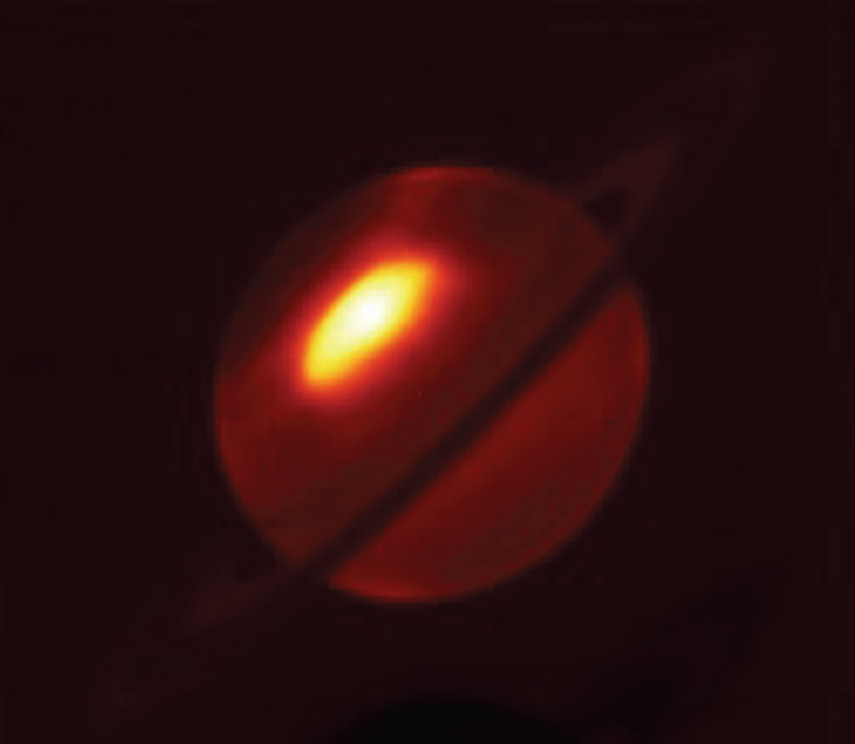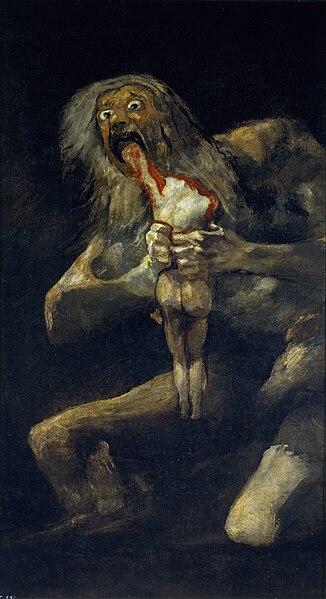NASA | JPL-Caltech | Cassini Solstice Mission | 2012 Oct 25
NASA's Cassini spacecraft has tracked the aftermath of a rare massive storm on Saturn. Data reveal record-setting disturbances in the planet's upper atmosphere long after the visible signs of the storm abated, in addition to an indication the storm was more forceful than scientists previously thought.Click to play embedded YouTube video.
Data from Cassini's composite infrared spectrometer (CIRS) instrument revealed the storm's powerful discharge sent the temperature in Saturn's stratosphere soaring 150 degrees Fahrenheit (83 kelvins) above normal. At the same time, researchers at NASA's Goddard Spaceflight Center in Greenbelt, Md., detected a huge increase in the amount of ethylene gas, the origin of which is a mystery. Ethylene, an odorless, colorless gas, isn't typically observed on Saturn. On Earth, it is created by natural and man-made sources.
Goddard scientists describe the unprecedented belch of energy in a paper to be published in the Nov. 20 issue of the Astrophysical Journal.
"This temperature spike is so extreme it's almost unbelievable, especially in this part of Saturn's atmosphere, which typically is very stable," said Brigette Hesman, the study's lead author and a University of Maryland scientist who works at Goddard. "To get a temperature change of the same scale on Earth, you'd be going from the depths of winter in Fairbanks, Alaska, to the height of summer in the Mojave Desert."
First detected by Cassini in Saturn's northern hemisphere on Dec. 5, 2010, the storm grew so large that an equivalent storm on Earth would blanket most of North America from north to south and wrap around our planet many times. This type of giant disturbance on Saturn typically occurs every 30 Earth years, or once every Saturn year.
Not only was this the first storm of its kind to be studied by a spacecraft in orbit around the planet, but it was the first to be observed at thermal infrared wavelengths. Infrared data from CIRS allowed scientists to take the temperature of Saturn's atmosphere and to track phenomena that are invisible to the naked eye.
Temperature measurements by the composite infrared spectrometer, first published in May 2011, revealed two unusual beacons of warmer-than-normal air shining brightly in the stratosphere. These indicated a massive release of energy into the atmosphere. After the visible signs of the storm started to fade, the instrument's data revealed the two beacons had merged. The temperature of this combined air mass shot up to more than minus 64 degrees Fahrenheit (above 220 kelvins).
According to Hesman, the huge spike of ethylene generated at the same time peaked with 100 times more of the gas than scientists thought possible for Saturn. Goddard scientists confirmed the release of ethylene using the Celeste spectrometer mounted on the McMath-Pierce Solar Telescope on Kitt Peak in Arizona.
The team still is exploring the origin of the ethylene, but has ruled out a large reservoir deep in the atmosphere.
"We've really never been able to see ethylene on Saturn before, so this was a complete surprise," said Goddard's Michael Flasar, the CIRS team lead.
A complementary paper led by Cassini team associate Leigh Fletcher of Oxford University, England, describes how the two stratospheric beacons merged to become the largest and hottest stratospheric vortex ever detected in our solar system. Initially, it was larger than Jupiter's Great Red Spot.
Their paper in the journal Icarus, which combines CIRS data with additional infrared images from other Earth-based telescopes, including NASA's Infrared Telescope Facility at Mauna Kea, Hawaii, also reports a powerful collar of clockwise winds -- encompassing a bizarre soup of gases -- around the vortex.
"These studies will give us new insight into some of the photochemical processes at work in the stratospheres of Saturn, other giants in our solar system, and beyond," said Scott Edgington, Cassini deputy project scientist at NASA's Jet Propulsion Laboratory in Pasadena, Calif.
After-Effects of Saturn’s Super Storm Shine On
ESA Space Science | 2012 Oct 25
The heat-seeking capabilities of the international Cassini spacecraft and two ground-based telescopes have provided the first look at the aftermath of Saturn’s ‘Great Springtime Storm’. Concealed from the naked eye, a giant oval vortex is persisting long after the visible effects of the storm subsided.Click to play embedded YouTube video.
The ground-based observations were made by the Very Large Telescope of the European Southern Observatory in Chile, and NASA’s Infrared Telescope Facility at the summit of Mauna Kea in Hawaii.
The vivid cloud structures that wreaked havoc across wide swathes of the mid-northern latitudes of Saturn’s atmosphere captured the imaginations of amateur and professional astronomers alike, from its first appearance in December 2010 through much of 2011.
But in new reports that focus on the temperatures, winds and composition of Saturn’s atmosphere, scientists find that the spectacular cloud displays were only part of the story.
Much of the associated activity took place beyond the reach of visible-light cameras, and the after-effects are still continuing today.
“It’s the first time we’ve seen anything like it on any planet in the Solar System,” says Leigh Fletcher from the University of Oxford, UK, lead author of the Icarus paper.
“It’s extremely unusual, as we can only see the vortex at infrared wavelengths – we can’t tell that it is there simply by looking at the cloud cover.”
As the visible storm erupted in the roiling cloud deck of Saturn’s troposphere, waves of energy rippled hundreds of kilometres upwards, depositing their energy as two vast ‘beacons’ of hot air in the stratosphere.
The beacons were expected to cool down and dissipate, but by late April 2011 – by which time bright cloud material had encircled the entire planet – the hot spots had merged to create an enormous vortex that for a brief period exceeded even the size of Jupiter’s famous Great Red Spot.
Furthermore, the temperature of the vortex was far higher than expected, some 80ºC warmer than the surrounding atmosphere. At the same time, huge spikes in the amount of gases like ethylene and acetylene were detected.
Much like the Great Red Spot, Saturn’s vortex also cuts off the atmosphere in its core from the surrounding environment, constraining its unique chemistry and high temperatures within the walls of the powerful winds whipping around the edge.
“But Jupiter’s vortex is embedded deep down in the turbulent ‘weather zone’, whereas the vast vortex on Saturn is higher up in the atmosphere where, normally, you wouldn’t expect anything like it to have formed,” says Dr Fletcher.
“Although there are parallels to be drawn between the two, the mechanisms by which they were formed and the length of time they are going to exist seem to be very different.”
Jupiter’s famous vortex has raged for at least 300 years, but after traversing the planet once every 120 days since May 2011, Saturn’s large beacon is cooling and shrinking. Scientists expect it to fade away completely by the end of 2013.
The question now remains as to whether Saturn’s storm-generating energy has been sapped or if there will be a repeat performance.
The outburst already caught observers by surprise by arriving during the planet’s northern hemisphere spring, years ahead of the predictably stormy summer season.
“The beauty is that Cassini will be operating until the Saturn system reaches its summer solstice in 2017, so if there is another global event like this, we’ll be there to see it,” says ESA’s Cassini project scientist Nicolas Altobelli.
Saturn's giant storm reveals the planet's churning atmosphere
ESA Science & Technology | Cassini-Huygens | 2012 Oct 25
The origin and evolution of Saturn’s 2011–2012 stratospheric vortex - Leigh N. Fletcher et al
- Icarus 221(2) 560 (Nov–Dec 2012) DOI: 10.1016/j.icarus.2012.08.024
Giant “Invisible” Vortex Still Remains on Saturn Following Huge Storm
Universe Today | Nancy Atkinson | 2012 Oct 25
Saturn storm cranks the heat WAY up
Discover Blogs | Bad Astronomy | 2012 Oct 26




